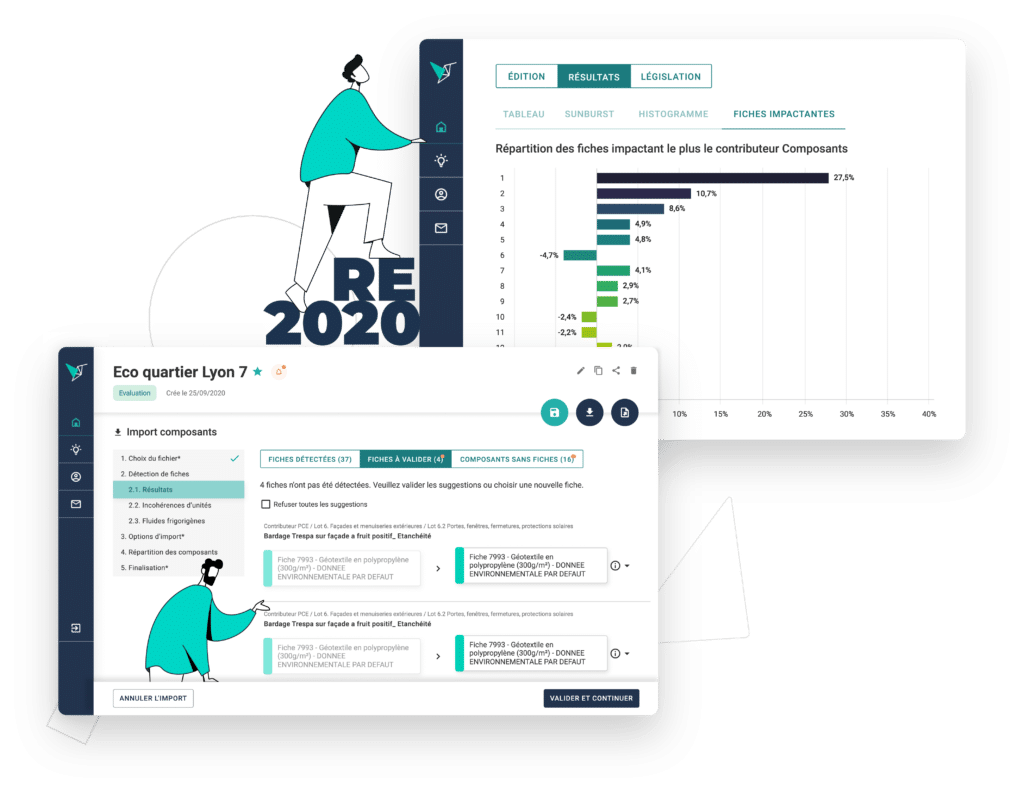ACV ou Analyse du Cycle de Vie d’un bâtiment
Définition et description de ce qu’est l’Analyse du Cycle de Vie d’un bâtiment, la méthodologie et le dispositif réglementaire l’encadrant.

Qu’est-ce que c’est et à quoi ça sert ?
L’Analyse de Cycle de Vie est une méthode d’évaluation des impacts environnementaux d’un bâtiment sur l’ensemble de son existence : de la conception jusqu’à la gestion de sa fin de vie.
Il s’agit d’une méthode scientifique qui permet la comparaison d’alternatives à l’aide d’une approche quantitative.
- Normalisée (qui consiste à évaluer les impacts environnementaux d’un système sur un périmètre donné (NF EN ISO 14040))
- Multicritère
- Quantitative
Au final, l’ACV bâtiment a pour objet de quantifier les flux d’énergie, de matière et d’eau, entrants ou sortants, et ce pour chaque étape du cycle de vie du bâtiment, et de traduire leur impact sur l’environnement à travers différentes catégories d’impact (comme le changement climatique, l’épuisement des ressources ou l’acidification des sols).
Comment l'analyse de cycle de vie ACV S'applique-t-elle aux différents domaines du secteur du bâtiment ?
L’ACV dans le secteur de la construction s’applique à deux domaines: l’un concerne la fabrication de composants et l’autre l’évaluation du scénario complet de conception du bâtiment.
Il s’agit de prendre en compte les quantités de matériaux utilisés, les choix de conception architecturale effectués, etc.17 févr. 2021.
Quelles sont les étapes prises en compte dans le cadre de l’ACV d’un bâtiment ?
L’ACV Bâtiment a pour principe de prendre en compte l’ensemble des étapes impliquées dans le cadre d’un projet de construction. Elle commence par l’extraction des matières premières nécessaires à la production des produits de construction, et s’achève par la fin de vie du bâtiment.
Entre ces deux étapes, elle comprend l’ensemble des phases intermédiaires : traitement des déchets, exploitation, impacts liés à l’acheminement des composants, etc.
Dans le détail, il est possible de décomposer cette analyse du cycle de vie en 5 grandes étapes :
- Production (A1-A3) : Acquisition des matières premières, transport vers l’usine de transformation et fabrication du produit manufacturé
- Construction (A4-A5) : Transport du produit vers le chantier, processus de construction et d’installation des matériaux et produits finis lors du chantier de construction
- Utilisation (B1-B7) : Toute la vie en œuvre du bâtiment, cela inclus : l’utilisation, la maintenance, la réparation, le remplacement des matériaux et produits finis, les consommations d’énergie et d’eau pendant l’utilisation du bâtiment
- Fin de vie (C1-C4) : Déconstruction de l’ouvrage, transport vers le lieu de valorisation ou d’élimination, traitement et élimination des matériaux et produits finis.
- Bénéfices et charges au-delà du cycle de vie (D): que devient le produit après sa fin de vie ? Quels externalités positives peut-on tirer de son réemploi ?
Quelles sont les étapes pour réaliser une ACV ?
Le cadre méthodologique de l’ ACV est encadré et s’appuie sur la norme ISO 14044. Pour réaliser une Analyse du Cycle il faut :
- Dans un premier temps définir le périmètre et les objectifs de l’étude,
- Réaliser et analyser l’inventaire (Inventaire du Cycle de Vie / ICV),
- Calculer et évaluer les impacts liés à cet inventaire,
- Et enfin interpréter l’ensemble des résultats obtenus.
Quelle est la norme européenne encadrant l’ACV des bâtiments ?
La norme NF EN 15978 » Contribution des ouvrages de construction au développement durable – Évaluation de la performance environnementale des bâtiments – Méthode de calcul » fournit depuis 2012 la méthode de calcul européenne reposant sur l’ACV et d’autres informations environnementales quantifiées.
Quelle est la norme française encadrant l’ACV Bâtiment ?
La Réglementation Environnementale 2020 (RE 2020), entrée en vigueur le 1er janvier 2022 s’applique désormais à l’ensemble des logements collectifs en France.
Après des phases d’expérimentations et de concertations, notamment avec le label E+C- depuis 2016, elle succède à la Réglementation Thermique RT 2012.
Découvrez nos logiciels Vizcab pour certifier et labéliser vos projets de construction bas carbone
De la phase de diagnostique et faisabilité à la phase d’exécution d’un projet de construction, nous vous proposons des logiciels adaptés pour chaque professionnel pour bâtir votre stratégie bas carbone.



En phase amont
Dès l'esquisse, sécurisez l'objectif coût / carbone de vos projets.
Optimisez votre rentabilité d’un projet en jouant sur les paramètres les plus impactants pour atteindre vos objectifs et fédérez les acteurs grâce à des supports de communication percutants.

En phase aval
Calculez et optimisez l'impact environnemental de vos projets
Vizcab Eval la solution pour vous permettre de produire des études ACV bâtiment fiables, robustes et percutantes en un minimum de temps.
